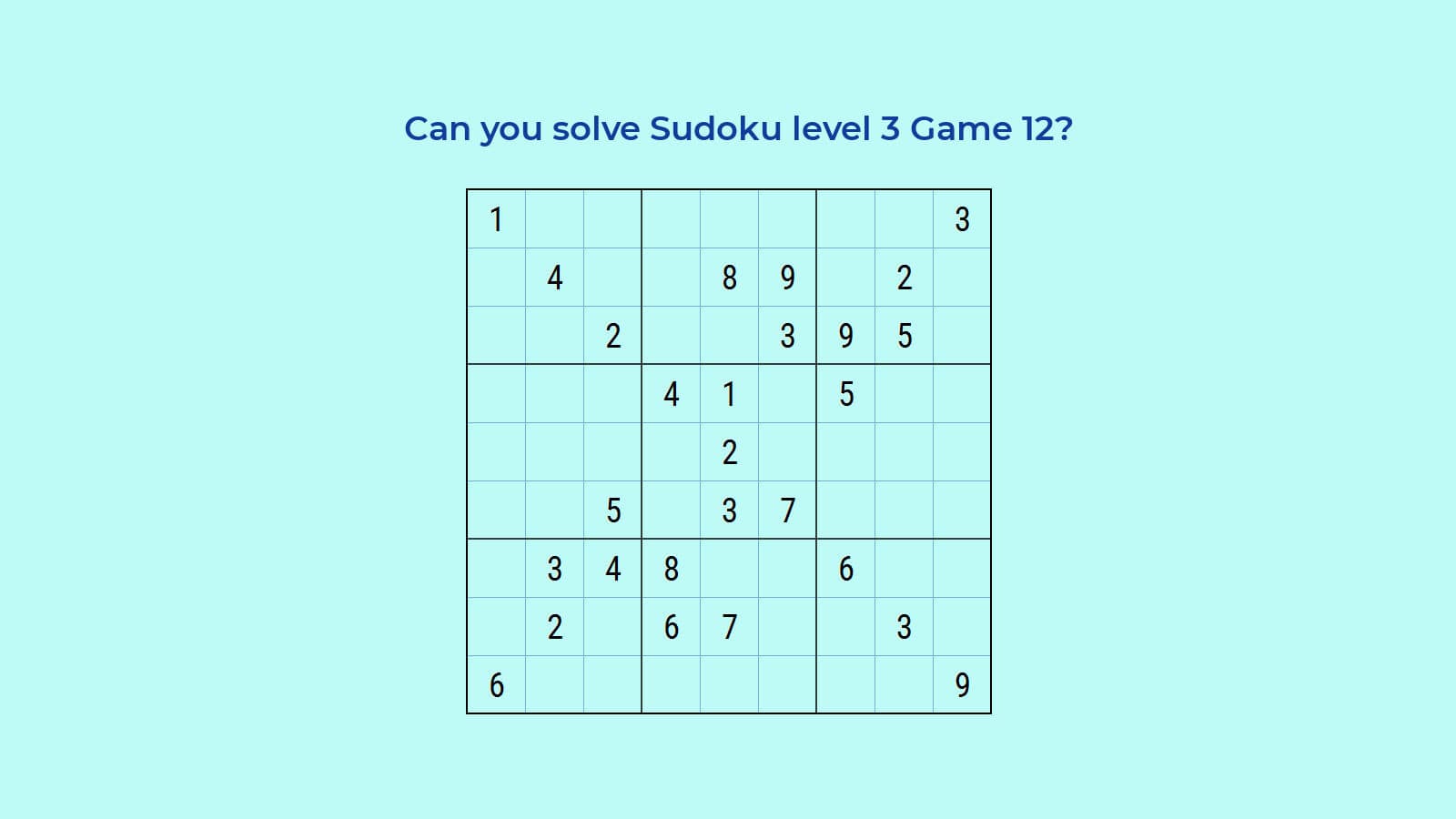
Step by step solution to Sudoku hard level 3 game 12 by Sudoku techniques
Learn how to solve Sudoku hard level 3 game 12 quickly by forming and using advanced Sudoku techniques of parallel digit scan and X wing formation.
First the solution to the Sudoku hard level 3 game 12 explained in full details. It includes explanation on how a specific Sudoku technique works.
The Sudoku hard level 3 game 12 solution is followed by a brief on Strategy of solving a Sudoku game.
Following are the contents with a few internal inks,
- Solution to the Sudoku hard level 3 game 12.
- Sudoku technique of valid cell by possible digit analysis or DSA in solution stage 1 - This is the most frequently used multi-purpose Sudoku technique, used for finding a valid cell and also to form the possible digit subsets of empty cells.
- Sudoku technique of simplification by Cycles of digits in solution stage 2 - Forming a Cycle may directly result in a valid cell, but if not, even then a Cycle reduces the overall uncertainty in a game.
- Sudoku technique of breakthrough by X wing digit pattern in Solution stage 1 - This is an advanced digit pattern of more power for creating a breakthrough.
- Sudoku technique of valid cell by Parallel digit scan in solution stage 1- This is a quick method of getting a valid call instead of getting it by forming a time-consuming Cycle.
- Strategies of solving a Sudoku hard puzzle game.
The game below is followed by its solution, Sudoku techniques used and the strategies for solution. You may switch between the sections with links by clicking on a link and after going through it, returning by clicking on browser back button.
First try to solve the game before going through its solution.
Sudoku hard level 3 puzzle game 12
The following is the Sudoku hard puzzle that should engage your mind for some time.
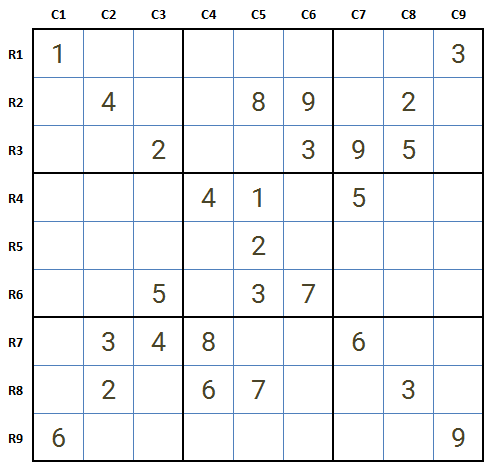
You may go through the next three sections for learning strategies and techniques for solving Sudoku puzzles in brief. Or, you may skip.
Solution to the Sudoku hard level 3 puzzle game 12 Stage 1: Breakthrough by parallel digit scan and X wing
We'll explain the solution in segments of stages so that from the game status at the end of each stage, how the valid cells are obtained using Sudoku techniques can be understood without any difficulty.
Cell highlighting: Valid Cell color at this first stage is banana leaf green. This color for these valid cells is preserved throughout. And Cycles are colored yellow.
First valid cell by row column scan is for 3: R9C4 3 by scan for 3 in C5, C6. And that's all by row column scan.
Parallel scan for 9 on empty cells of C5:
9 in R9 eliminates R9C5 for 9 and 9 in top middle major square eliminates the other two empty cells in C5 for 9. Only the single cell R7C5 is left for 9: R7C5 9.
A valid cell by parallel scan is invariably associated with formation of a Cycle in rest of the cells. For example in this case, a Cycle (1,2,5,7) is formed in rest of the four empty cells of R7.
We could have got the valid cell R7C5 9 by first forming this Cycle by possible digit analysis. But that would have been time-consuming. That's why we prefer to identify a hit by parallel scan whenever we can.
Get a valid cell and a Cycle by DSA in Central middle major square:
R6C4 9 by DSA reduction of [5,6,8] (5 in R6 and [6,8]) from possible digit subset DS [5,6,8,9] in central middle major square -- R5C4 5 by reduction of 9 -- Cycle (6,8) in R4C6, R5C6 of central middle square and C6.
Parallel scan for 2 on empty cells of C4:
2 in R2, and R3 leaves the single cell R1C4 for 2 -- Cycle (1,7) in C4 -- Cycle (4,5) in R1C4, R1C5 by reduction of 6 caused by Cycle (6,8) in C6.
Important breakthrough by X wing:
Now we'll identify and use a powerful Sudoku digit pattern of a full height X wing comprising of 4 instances of same digit 5 in four cells.
Observe how digit 5 can be placed in only two cells R1C2 and R9C2 in column C2.
This is because, 5 in left middle major square eliminates three empty cells in C2 for 5 and 5 in R3 eliminates the fourth empty cells R3C2 for 5.
Similarly 5 can be placed in only the two cells R1C5 and R9C5 because out of three empty cells of C5, R3C5 is eliminated for 5 by 5 in R3.
The diagonally opposite pairs of digit 5s are joined together by red colored lines to show that the formation looks like a large X. As in C2 or C5, one of the two cells have the digit 5 in the final solution, and also as the pairs have common columns C2 and C5 but also have common rows R1 and R9, together this formation,
DISALLOWS PLACEMENT OF DIGIT 5 IN ANY EMPTY CELL OF THE COMMON ROWS AND COLUMNS of the X wing.
You can check the truth of this statement by placing 5 in R1C2. That eliminates 5 in both R1C5 and R9C2, so that 5 must occur in the diagonally opposite cell R9C5.
In the same way, if you place 5 in R1C5, it must occur then only in R9C2, the diagonally opposite cells. In either case both the rows R1, R9 and both the columns C2 and C5 are disallowed for 5 in any other cell.
By this reduction of 5 from possible digit subset in R1 and in R1C6, DS in R1C6 is reduced from (4,5) to the single digit 4 -- R1C6 4. This is the important breakthrough.
The two pairs of the same digit sharing a pair of rows or both rows and columns is called X wing which is a very potent Sudoku digit pattern to identify. It invariably produces an important breakthrough.
Game status at this stage shown below.
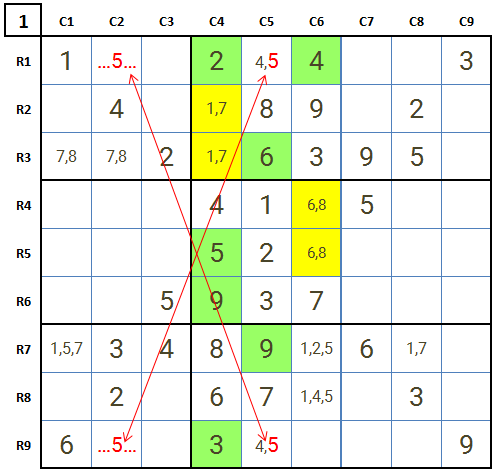
Solution to the Sudoku hard level 3 puzzle game 12 Stage 2: Cycle of digits explained
Valid cell color at this second stage is light blue and it is preserved throughout. Cycle color is yellow and adjacent Cycle color light orange.
Because of R3C5 6, a Cycle (7,8) formed in R3C1, R3C2 by DSA reduction of [1,4,6] from DS [1,4,6,7,8] in R3 -- R3C4 1 by reduction of 7 because of Cycle (7,8) -- R2C4 7 by reduction -- R1C5 5 by exception -- R9C5 4 by exception in C5 -- R9C2 5 by X wing reduction property of valid diagonally opposite digit.
The valid diagonally placed pair of digit 5s of the now gone X wing are indicated by the arrow line joining the two.
R3C9 4 by exception.
R2C7 1 by DSA reduction of [6,7,8] from DS [1,6,7,8] in top right major square -- R2C9 6 by DSA reduction of [7,8] in R2 from DS [6,7,8] in top right major square -- Cycle (7,8) formed in R1C7, R1C8 -- a second Cycle (6,9) formed in the remaining two cells of R1C2, R1C3 -- DS in top left major square reduced to [3,5] -- R2C3 3 by reduction of 5 in C3 -- R2C1 5 by reduction and exception in R2.
R7C1 7 by DSA reduction of [1,2,5] from DS [1,2,5,7] in R7 -- R7C8 1 by DSA reduction of [2,5] from DS [1,2,5] in R7 -- Cycle (2,5) in R7.
With 7 in R7C1, R3C1 8 by reduction -- R3C2 7 by reduction.
With 1 in C1, R8C1 9 by DSA reduction of [1,8] from DS [1,8,9] in bottom left major square -- By DSA a Cycle (7,8) formed with [7,8] in R1C8, [1,7] in R7C8 and [1,7,8] in R9C8.
This helps to form a second Cycle of remaining three digits (4,6,9) in remaining three cells R4C8, R5C8 and R6C8 of C8 and right middle major square.
A Cycle: These three digits are locked or Cycle inside these three cells of C8 and also the right middle major square. In no other empty cell of C8 or the right middle major square, these three digits [4,6,9] can appear. For a proper Cycle, every digit must appear at least twice in the cells involved in the Cycle. A Cycle is valuable asset to have as it simplifies overall game and often produces a breakthrough.
Game status at the end of stage 2 shown below.
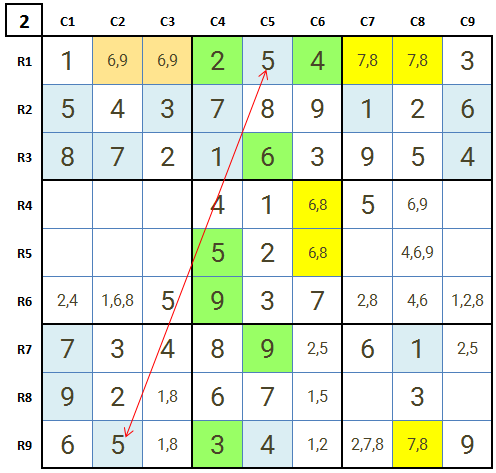
Solution to the Sudoku hard level 3 puzzle game 12 Stage 3
Valid cell color at this third stage is pink if this not the final stage. Final stage color is always light cyan or lime green.
By DSA in cell R6C7 we get the DS [2,8] and this joins with [7,8] in R1C7 and [2,7,8] in R9C7 to form another Cycle [2,7,8] in C7.
The two digits missing in C7 are [3,4] and with 3 in R8, we get the valid cell R8C7 4 and also R5C7 3.
R4C1 3 by scan for 3 in R5, R6, C2, C3.
Possible digits left in two cells of C1 [2,4] and with 2 in R5, R5C1 4 by DSA reduction of 2 -- R6C1 2 by exception in C1.
We'll keep this stage short with only five valid cell finds and all challenges for the final fourth stage are over.
Game status at the end of Stage 3 solution shown below.
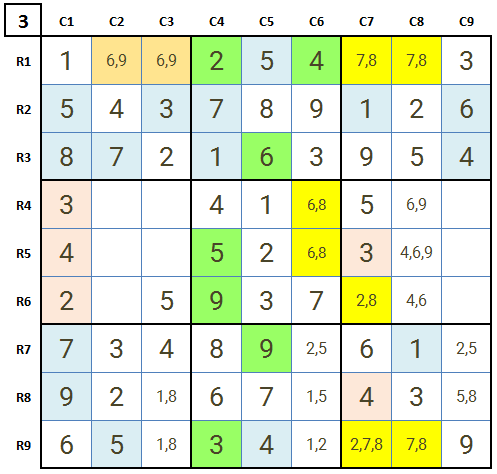
Solution to the Sudoku hard level 3 puzzle game 12 Final Stage 4
Valid cell color at this last stage is always light cyan or lime green.
With 2 in R6C1, R6C7 8 by reduction -- R1C7 7 by reduction -- R1C8 8 by reduction -- R9C8 7 by reduction -- R9C7 2 by reduction -- R7C9 5 by reduction -- R8C9 8 by reduction -- R8C3 1 by reduction -- R9C3 8 by reduction -- R9C6 1 by exception in R9 -- R8C6 5 by reduction -- R7C6 2 by reduction.
Possible digit subset in three empty cells of C9 is [1,2,7] and with DS [2,7] in R6, R6C9 1 by reduction -- R5C9 7 by reduction -- R4C9 2 by reduction.
R4C3 7 by scan for 7 in R5, R6, C2. R6C8 4 by scan for 4 in R4, R5 -- R6C2 6 by exception in R6 -- R1C2 9 by reduction -- R1C3 6 by reduction -- R5C3 9 by exception in C3 -- R5C8 6 by reduction -- R4C8 9 by reduction -- R5C6 8 by reduction -- R4C6 6 by reduction.
R4C2 8 by exception in R4 and R5C2 1 by exception in whole game.
Final solution shown below.
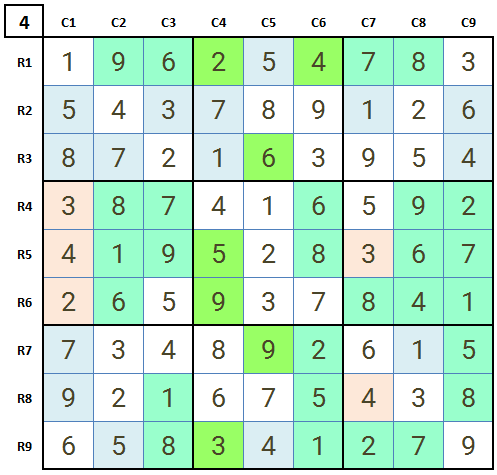
Sudoku strategy adopted for quick and easy solution
As a strategy we always try first—the row-column scan to find the valid cell at any stage because that is the most basic and easiest of all techniques.
Hardness level being higher now, easy breaks by row-column scan are not many in the beginning.
So the next easy to use technique used is—identification of single valid digit for a cell by Digit Subset Analysis or DSA in short.
And wherever possible, Cycles of digits are formed that in any situation are a treasure to have and Cycles play a key role in quick solution.
You may wait for Cycles to form automatically in a column or row, but a proactive approach of forming a Cycle by DS analysis speeds up the solution process considerably.
When the easier techniques are no longer applicable, short length of 2 to 3 digit long possible digit subsets or DSs are evaluated in favorable cells belonging to favorable zones (having a larger number of cells already filled) quickly.
Objective now is to identify and use the higher level advanced Sudoku techniques of Single digit lock, X wing or parallel digit scan for creating a breakthrough.
Usually an often prescribed method of evaluating DSs of all empty cells is avoided as it is more time-consuming compared to valid cell identification using special digit patterns first.
At this level 3 hard Sudoku, number of breakthroughs that are needed are not many and overall going is not hard at every step continuing till the end. After the few barriers are overcome, finding rest of valid cells is easy.
The main strategy for solving a hard Sudoku puzzle is to use the technique that would produce best results fastest. Easy to say, not so easy to do—comes with practice.
End note
Any puzzle solving involves essentially problem solving. The general steps are,
- First stage analysis and breaking it down into smaller chunks if possible as well as adapt the strategy of solving this type of problem,
- Solving the easier component problems so that the main problem size and complexity is reduced,
- Detailed information collection, that is, defining the problem in more details as far as possible,
- Second stage analysis of structure of problem (in this case of Sudoku) and information content,
- Key pattern identification,
- Use of the key pattern to create the breakthrough,
- Repeating the last four steps (steps 4, 5, 6 and 7) for finally solving the problem.
This Sudoku level 3 game is with a relatively larger number of 27 cells already filled with digits. But still it poses a series of hurdles that needed use of advanced Sudoku techniques of X wing and parallel scan.
This gives you a good Sudoku hard solving practice before graduating soon to solving level 4 Sudoku hard games.
Watch out for the next 3rd level Sudoku puzzle solution.
More Sudoku hard puzzles you may like to solve and learn how to solve
The updated list of Solutions to level 3, level 4 and NYTimes Sudoku hard puzzle games:
How to solve Sudoku hard puzzle games full list (includes very hard Sudoku).
Enjoy solving Sudoku hard.
By the way, Sudoku hard solution techniques are included with many of the solutions.
Enjoy also learning how to solve Sudoku hard in easy steps.
